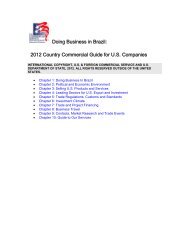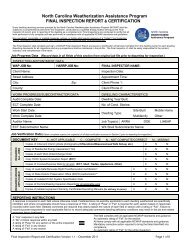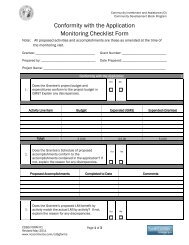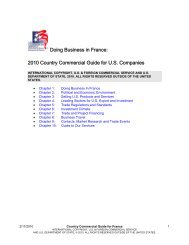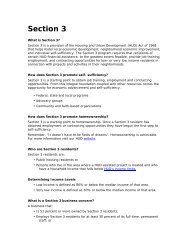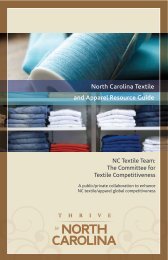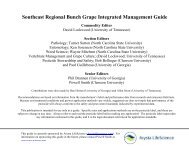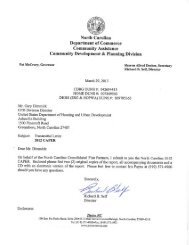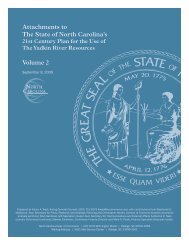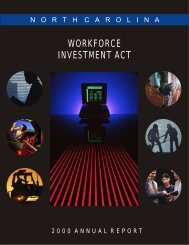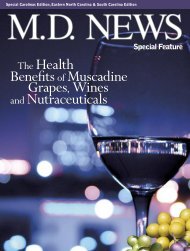the DGN, which, in turn, informs the laboratory <strong>of</strong> the results. Those applicants notreceiving authorization are permitted to make the necessary modifications to theirfacilities in order to comply with standards NMX-CC-13-1992 and NMX-CC-14-1992.After the committee verifies that the laboratory meets the requirements, a second reportis prepared for the DGN.Authorizations as Test Laboratories are valid for two years and can be renewed uponwritten request. Test laboratories are required to maintain their technical capabilities andto make any modifications that the committee may set. Test laboratories must notify theDGN <strong>of</strong> any change in equipment, location, and administration. Laboratories have theoption to withdraw their certification.Verification Units:Verification or inspection units check and provide a report or pro<strong>of</strong> <strong>of</strong> compliancecorroborated either visually or by sampling, measuring, testing in laboratories, orexamining documents. Labeling NOMs, for example, do not require products to obtain acertificate <strong>of</strong> compliance; however, verification units can determine whether or not atechnical regulation has been correctly applied.On June 18, 2001, the Mexican standard NMX-EC-17020-IMNC-2000 (equivalent toISO/IEC 17020:1998) entered into force in order to make the accreditation process <strong>of</strong>verification units consistent with international standards. Therefore, as <strong>of</strong> January 2002,the procedure to evaluate and accredit verification units became effective.Publication <strong>of</strong> Technical RegulationsReturn to topNational Gazette: The Mexican national gazette is the Diario Oficial de la Federación.Publication <strong>of</strong> Proposed Technical Regulations:<strong>In</strong> accordance with the Regulation <strong>of</strong> the Federal Law <strong>of</strong> Metrology and Standardization(Reglamento de la Ley Federal sobre Metrología y Normalización, LFMN), the NationalProgram <strong>of</strong> Standardization (Programa Nacional de Normalización, PNN) is the <strong>of</strong>ficialdocument used to plan, inform and coordinate the standardization activities, both publicand private, carried out by the Mexican government. The PNN is made up <strong>of</strong> a list <strong>of</strong>topics that will be developed into Official Mexican Standards (NOMs), technicalregulations, Mexican Standards (NMX’s), and Reference Standards (NRF’s)--as well asapproximate a working calendar for each respective topic. The program is equallycomposed <strong>of</strong> information from the National Consulting Standardization Committees(Comités Consultivos Nacionales de Normalización), which are responsible for thecreation <strong>of</strong> NOMs; the Technical Committees <strong>of</strong> National Standardization (ComitésTécnicos de Normalización Nacional) and the National Standardization Bodies(Organismos Nacionales de Normalización), both <strong>of</strong> which are responsible for thecreation <strong>of</strong> NMXs; and 2 Standardization Committees (Comités de Normalización),responsible for the creation <strong>of</strong> NRF’s - standards created by governmental entities forgovernment procurement.The PNN is annually developed by the Technical Secretariat <strong>of</strong> the NationalStandardization Commission, revised by the Technical Council <strong>of</strong> the aforementionedentity, and approved by the National Standardization Commission (CNN, ComisiónNacional de Normalización) in its first meeting <strong>of</strong> every year.
The LFMN and its Regulation establish a time frame for each step <strong>of</strong> the NOM-makingprocess (development, draft publication in the Official Gazette (DOF), and publication <strong>of</strong>modified and definitive technical regulations and standards) and within the PNNframework, the accomplishment <strong>of</strong> these tasks is limited to the span <strong>of</strong> a year. Theactual NOM-making period, however, is contingent upon various factors, including thecomplexity <strong>of</strong> the topic and the uncertain period between each step (i.e. publishingperiod in the Official Gazette (DOF)—draft, response, comments, and final technicalregulation and standard). Therefore, evaluations <strong>of</strong> the PNN indicate, more <strong>of</strong>ten thannot, that the standardization process requires more than a year in order to adequatelymeet its objectives.U.S. entities can participate in the process in several ways. They can:• Review the PNN with the objective <strong>of</strong> learning about the topics to be standardized.• Request to be included in the applicable working group directly from the appropriate<strong>of</strong>fice (requires physical presence).• Present commentaries during the 60-day public consultation period.Solicit the making, modification, or cancellation <strong>of</strong> technical regulations and standards(NOM and NMX) to the appropriate government <strong>of</strong>fice or to a National StandardizationBody.Labeling and MarkingReturn to topAll products intended for retail sale in Mexico must bear a label in Spanish prior to theirimportation to Mexico. Products that must comply with commercial andcommercial/sanitary information NOMs must follow the guidelines as specified in theapplicable NOM. Most NOMs require commercial information to be affixed, adhered,sewn, or tagged onto the product, with at least the following information in Spanish:• <strong>Name</strong> or business name and address <strong>of</strong> the importer,• <strong>Name</strong> or business name <strong>of</strong> the exporter,• Trademark or commercial name brand <strong>of</strong> the product,• Net contents (as specified in NOM-030-SCFI-2006 DOF November 4, 2006),• Use, handling, and care instructions for the product as required,• Warnings or precautions on hazardous products.This information must be attached to the product, packaging or container, depending onthe product characteristics. This information must be affixed to products as prepared forretail sale. Listing this information on a container in which a good is packed for shipmentwill not satisfy the labeling requirement.NOMs do not explicitly state that country <strong>of</strong> origin is required on the label prior toimportation. However, Mexican fiscal regulations do require country <strong>of</strong> origindesignation, and the U.S. <strong>Department</strong> <strong>of</strong> Commerce recommends that exporters includethis information, in Spanish, on the labels they are preparing for goods destined for retailsale in the Mexican market. Along this line, including the importer's taxpayer number(commonly known as RFC) is recommended.
- Page 1:
Doing Business in Mexico: 2010 Coun
- Page 4 and 5:
Return to table of contentsChapter
- Page 6 and 7:
Before signing an agent/distributor
- Page 8 and 9:
In order to satisfy clients’ dema
- Page 10 and 11:
egardless of their geographic proxi
- Page 12 and 13:
The following companies organize tr
- Page 14 and 15:
to create a solid contract that inc
- Page 17 and 18: Web ResourcesReturn to topU.S. Gove
- Page 19 and 20: AgribusinessOverviewReturn to top20
- Page 21 and 22: Automotive Parts and SuppliesOvervi
- Page 23 and 24: ResourcesState of Jalisco Auto-part
- Page 25 and 26: • Corporate training programs in
- Page 27 and 28: excluding large hydroelectric proje
- Page 29 and 30: Environmental SectorOverviewReturn
- Page 31 and 32: Franchising SectorOverviewReturn to
- Page 33 and 34: Hotel and Restaurant EquipmentOverv
- Page 35 and 36: Housing and Construction ServicesOv
- Page 37 and 38: Internet and IT ServicesOverviewRet
- Page 39 and 40: Packaging EquipmentOverviewReturn t
- Page 41 and 42: With this boom in the packaging sec
- Page 43 and 44: • Integrated security solution(co
- Page 45 and 46: CATV: Today 30% of homes have pay-T
- Page 47 and 48: and expanding facilities and servic
- Page 49 and 50: destinations are typically not popu
- Page 51 and 52: The United States’ major agricult
- Page 53 and 54: 5.- Fresh Fruit (apples, pears, gra
- Page 55 and 56: ResourcesReturn to topThe USDA’s
- Page 57 and 58: order region and 16 percent for pro
- Page 59 and 60: U.S. Export ControlsReturn to topMe
- Page 61 and 62: and organs, almost all medical prod
- Page 63 and 64: Organizations that develop NMX - Me
- Page 65: Certification Bodies:EMA has accred
- Page 69 and 70: NOM-137-SSA1-2008 Regulatory inform
- Page 71 and 72: Mexico is the country with the larg
- Page 73 and 74: Return to table of contentsChapter
- Page 75 and 76: SECTION 2: SECTORS RESERVED FOR MEX
- Page 77 and 78: majority share (about 75 percent) o
- Page 79 and 80: Expropriation and CompensationRetur
- Page 81 and 82: contribution. The Mexican Bank for
- Page 83 and 84: Government continues to work with i
- Page 85 and 86: to banks and non-bank banks. Despit
- Page 87 and 88: government sent the sent the Federa
- Page 89 and 90: Business Transactions (OECD Antibri
- Page 91 and 92: • Information about the OECD Anti
- Page 93 and 94: Greece, Italy, Netherlands, Portuga
- Page 95 and 96: Foreign Direct Investment Realized
- Page 97 and 98: Return to table of contentsChapter
- Page 99 and 100: individuals who are equally new to
- Page 101 and 102: sector, which is expected to uncove
- Page 103 and 104: Return to table of contentsChapter
- Page 105 and 106: For further information please visi
- Page 107 and 108: Local Time, Business Hours, and Hol
- Page 109 and 110: Mr. Garth ThorburnDirector, U.S. Ag
- Page 111 and 112: Asociación Nacional de Importadore




